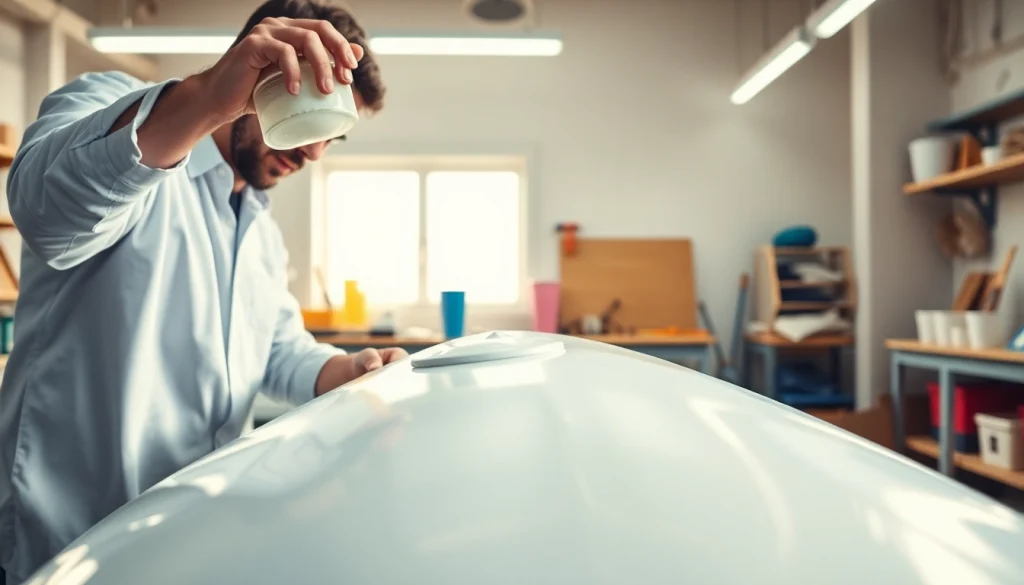Essential Guide to Laminating Resin: Applications and Techniques

Understanding Laminating Resin
What is Laminating Resin?
Laminating resin is a crucial material used in various industries, primarily for creating durable and robust composite structures. This type of resin is designed to bond layers of fiberglass or other reinforcing materials, thereby enhancing the strength and integrity of the final product. Commonly used in marine construction, automotive applications, and craft projects, laminating resin can withstand harsh environmental conditions, making it an indispensable tool for professionals and hobbyists alike. When selecting a high-quality laminating resin, it’s essential to consider its properties and compatibility with the materials you’ll be working with.
Types of Laminating Resin
There are several types of laminating resin available on the market, each with unique properties and applications. The most common varieties include:
- Polyester Laminating Resin: This is perhaps the most widely used type, favored for its affordability and ease of use. Polyester laminating resin is particularly effective in marine environments and is used in the construction of boats and other marine installations.
- Epoxy Laminating Resin: Known for its superior bonding capabilities and resistance to moisture, epoxy laminating resin is used for applications requiring high strength and durability. It is a preferred choice in aerospace and automotive industries due to its excellent performance in extreme conditions.
- Vinylester Laminating Resin: This type bridges the gap between polyester and epoxy, offering better resistance to water and chemicals compared to polyester while being more cost-effective than epoxy. It is often utilized in applications where corrosion resistance is vital.
Key Properties and Benefits
The choice of laminating resin can significantly affect the performance and longevity of the final product. Here are key properties and benefits associated with laminating resins:
- Strength: Laminating resins enhance the tensile strength of composite materials, allowing them to endure substantial stress and weight without deforming or breaking.
- Adhesion: A critical property of laminating resins is their exceptional bonding abilities. This enables layers of materials to adhere strongly, forming a unified structure.
- Resistance to Environmental Factors: Many laminating resins offer excellent resistance to moisture, UV radiation, and chemicals, making them suitable for outdoor and automotive applications.
- Versatility: Laminating resins can be combined with various fillers and additives, allowing for modifications to suit specific project requirements.
Applications of Laminating Resin
Laminating Resin in Marine Construction
The marine industry relies heavily on laminating resin, particularly polyester and epoxy types, to construct durable vessels. Boats and yachts benefit from the lightweight yet robust nature of composites made with laminating resins. These materials help resist water damage and offer significant improvements in performance and fuel efficiency. When laying fiberglass in marine applications, the resin maintains tackiness between coats, ensuring optimal adhesion. This property is essential for vertical layups, where maintaining the positioning of fiberglass layers is crucial.
Using Laminating Resin for Automotive Repairs
Laminating resin is increasingly utilized in automotive repairs, particularly in restoring and reinforcing components. From bodywork to structural elements, these resins can repair cracks and damages while maintaining the vehicle’s aesthetic. The process involves applying the resin over fiberglass cloth to create a solid, reinforced surface. Additionally, epoxy laminating resin provides excellent resistance to moisture and chemicals found in automotive environments, making it a reliable choice for repairs.
Home Projects with Laminating Resin
For DIY enthusiasts, laminating resin opens up a range of home project possibilities. From crafting furniture to creating art installations, the resin can be molded over various substrates, providing a customizable and durable finish. It is particularly popular in making custom countertops, tabletops, and decorative items. When engaging in home projects with laminating resin, the creative potential is vast, provided that the right techniques and safety measures are adhered to.
How to Work with Laminating Resin
Preparing the Workspace
Before beginning a project with laminating resin, it is crucial to prepare your workspace adequately. Ensure that the area is clean, dry, and well-ventilated. Cover surfaces to protect against spills and drips, and gather all necessary tools, including mixing containers, application brushes or rollers, and safety equipment. Adequate ventilation helps reduce exposure to fumes, ensuring a safer working environment.
Mixing and Applying Laminating Resin
Mixing laminating resin requires precision to achieve optimal results. Follow the manufacturer’s guidelines regarding resin-to-hardener ratios, as improper mixing can lead to curing issues. Generally, the resin and hardener should be mixed thoroughly to a uniform consistency before application. Once mixed, apply the resin to your substrate using a brush or roller, ensuring even coverage. Depending on the project, you might need to apply multiple layers. Allow appropriate curing time between applications to ensure each layer adheres well to the previous one.
Finishing Techniques with Laminating Resin
After the laminating resin has cured, you may want to consider finishing techniques for an aesthetically pleasing result. Common finishing techniques include sanding, polishing, or adding top coats for additional protection. Sanding can help achieve a smooth surface, but it’s important to use the right grades of sandpaper to avoid damaging the underlying layers. When polishing, use a non-abrasive cleaner to maintain the clarity and shine of the resin.
Safety Precautions when Handling Laminating Resin
Protective Gear and Equipment
Safety should always be a priority when working with laminating resin. Ensure that you wear appropriate personal protective equipment (PPE), including gloves, goggles, and a respirator mask, especially when sanding cured resin. Protective clothing can prevent skin contact with resins and solvents, reducing the risk of allergic reactions or chemical burns.
Proper Ventilation Practices
Proper ventilation is essential while working with laminating resin. Adequate airflow minimizes the accumulation of harmful fumes, providing a safer environment for application and curing. Where possible, work in outdoor or well-ventilated areas. If indoors, consider using exhaust fans or air purifiers to improve air circulation and reduce odor levels.
Disposing of Laminating Resin Safely
Proper disposal of unused laminating resin is critical to maintain environmental safety. Follow local regulations for hazardous waste disposal, ensuring that leftover resin does not contaminate soil or water sources. If you have leftover mixed resin, allow it to cure completely in a safe area before disposal. Once cured, the material becomes a non-toxic solid that can generally be discarded with regular trash.
Common Issues and Solutions in Laminating Resin Use
Dealing with Bubbles and Imperfections
One common challenge when working with laminating resin is the formation of bubbles during application. These bubbles can weaken the bond and affect the finish. To minimize bubbles, ensure thorough mixing and use a brush or roller to apply pressure, encouraging trapped air to escape. If bubbles do form, they can often be addressed by lightly sanding the area once the resin has cured and applying a fresh layer to fill the imperfections.
Understanding Curing Times
Curing times can vary significantly between different types of laminating resin, and understanding this aspect is crucial for successful application. Always consult the manufacturer’s instructions for specific curing times, as well as for ambient temperature and humidity recommendations. In general, laminating resins may take several hours to cure, but full strength may not be achieved for days, depending on environmental conditions.
Choosing the Right Laminating Resin for Your Project
Selecting the appropriate laminating resin is key to ensuring project success. Consider the specific demands of your application, such as the required strength, flexibility, and environmental resistance. For instance, projects exposed to water will benefit from polyester or epoxy laminating resin, whereas those needing chemical resistance may opt for vinylester resin. Additionally, consider application ease and working time to avoid issues during the project.







